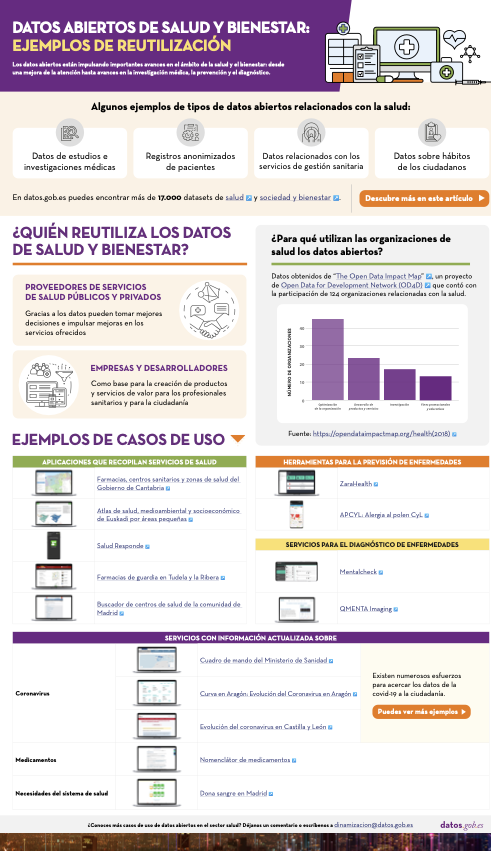In the last year, we have seen how decisions on health matters have marked the political, social and economic agenda of our country, due to the global pandemic situation resulting from COVID-19. Decisions taken on the basis of public data on cumulative incidence, hospital bed occupancy or vaccination rates have marked our daily lives.
This fact highlights the importance of open health data for the management and decision-making of our governments, but it is also fundamental as a basis for solutions that help both patients and doctors.
The types of data used in the field of health and wellbeing are numerous: results of medical studies and research, anonymised patient records, data on patients' habits (such as how much exercise we do or how much sleep we get) or data linked to health services and management. All these data are of great value that can be exploited by healthcare professionals, providers and citizens alike.
How have health services been using open data?
According to the study "The Open Data Impact Map", a project of the Open Data for Development Network (OD4D), health-related organisations use open data mainly for the purpose of optimising their management and organisation of resources. Of the 124 organisations interviewed in 2018, only 19 indicated that they use open data for the development of health products and services, and only 13 for research. The same study indicates that the most widely used open data are those directly related to health, and that very few organisations combine them with datasets from other themes - mainly geospatial or demographic or social indicators - to generate deeper and more detailed knowledge.
However, the opportunities in this field are vast, as shown below.
Click here to see the infographic in full size and in its accessible version
Examples of services based on open health data
The situation seems to be changing and there is increasing momentum for the implementation of applications, services or projects based on data in this field. Europe is committed to the creation of data spaces focused on the field of health, as part of its strategy to build a European cloud, while the Spanish government has included the promotion of Digital Health solutions in its Digital Spain 2025 strategy. Among the actions envisaged by our country is the streamlining of information systems to enable better data sharing and interoperability.
Applications that collect health services
When it comes to health apps, the most common are those that help citizens find local healthcare providers that meet their needs. An example is 24-hour pharmacies in Tudela and la Ribera or the search engine for health centres in the community of Madrid. Thanks to these, patients can find out where the centres are located and find out information of interest, such as opening hours. Some applications include additional services, such as Salud Responde, from the Junta de Andalucía, which allows the request and modification of medical appointments, improving the efficiency of the system.
But such services can also provide important information for more efficient resource management, especially when cross-referenced with other datasets. For example, Pharmacies, Health Centres and Health Areas of the Government of Cantabria, developed by Esri, includes information on the territorial organisation of health resources according to geographical, demographic, epidemiological, socio-economic, labour, cultural, climatological and transport factors. Its main objective is not only to facilitate citizens' access to this information, but also to ensure that "the provision of health services is carried out in the best conditions of accessibility, efficiency and quality".
The Health, environmental and socio-economic atlas of the Basque Country by small areas shows a series of maps with the aim of "monitoring geographical inequalities in health, socioeconomic and environmental indicators in the Basque Country, taking into account the gender perspective". This information is very useful for service managers in trying to promote greater equity in access to healthcare.
Disease prevention tools
There are also applications on the market aimed at disease prevention, such as ZaraHealth, a web application that displays real-time data on water quality, air quality and pollen levels in the city of Zaragoza. The user can set a series of thresholds for pollen and pollution levels, so that a warning is issued when they are reached. In this way, they can avoid going outdoors or exercising in areas that do not meet their needs. APCYL: Allergy to pollen CyL has the same goal.
Another important aspect of our health is our diet, a key factor in the prevention of various pathologies such as cardiovascular diseases or diabetes. Websites such as Mils, which offers detailed nutritional information on food, can help us to eat more healthily.
Services for the diagnosis and treatment of diseases
Open data can help assess health outcomes, develop more effective treatments and predict disease outbreaks.
In the field of mental health, for example, we find Mentalcheck, an app that enables psychological assessments and self-reporting via mobile devices. It aims to improve Ecological Momentary Assessment and Intervention (EMA and EMI). The application incorporates open data on medications and mental health services from the US Food and Drug Administration (FDA). It also allows the integration of psychological and physiological data to generate correlations.
Another example is Qmenta, a company focused on analysing brain data, using MRI and related clinical data. In recent months they have also incorporated open data related to COVID-19 in some of their work. Through medical image processing algorithms, they seek to accelerate the development of new therapies for neurological diseases.
Up-to-date information on diseases or system needs
Another area where open data can drive improvements is in the reporting of certain situations. This has become especially important in the context of the global pandemic where citizens demand constant and updated information. In this sense, we find the scorecard of the Ministry of Health at state level and different regional initiatives, such as Curve in Aragon: Evolution of Coronavirus in Aragon, or Evolution of the coronavirus in Castilla y León. These are just a couple of examples, but it should be noted that there are numerous efforts in this area, as the Ministry of Health reports on its website.
It is also important to make information on medicines transparent, both for doctors and patients, by facilitating comparisons. In this regard, the Nomenclature of Medicines shows more than 20,000 medicines marketed in Spain with Social Security coverage, offering information on price, presentation, links to the package leaflet, safety notes and active ingredients, among others.
Finally, it is also important to provide information on resource needs, for example, doctor vacancies or the state of blood reserves.
Data in general has driven important advances in improving health outcomes, from increased access to care to medical research and diagnosis. Open data is a key ingredient that can help further enrich these solutions with new variables. It is therefore essential that more and more health and wellness data will be opened, following a set of guidelines and standards that ensure the privacy and security of patients. In this sense, the report "Open data and health: technological context, stakeholders and legal framework" includes information on what types of data can be opened and what the legal framework says about it.
Do you know more use cases of open data applied to the health and welfare sector? Leave us a comment or write to dinamizacion@datos.gob.es.
Content prepared by the datos.gob.es team.
Open data is a source of information for the development of smart services, as well as for decision-making and policy-making. It is therefore not surprising that an increasing number of public bodies, in addition to opening data - for reuse by others and for reasons of accountability and transparency - are also reusing their own data for different purposes.
In this sense, the rise of smart city management platforms is encouraging many city councils and autonomous communities to develop smart applications and tools that take advantage of the use of data and analytical techniques to innovate and improve the public services they offer to citizens. Below, we show you several examples.
Resource optimisation
Open data can be used by public bodies to understand how public resources are being managed, as well as to promote actions that enable more efficient management and economic savings, e.g. in terms of energy consumption or by promoting more efficient resource management.
Energy consumption scorecard. Junta de Castilla y León.
This energy datahub, developed by the open data initiative of the Junta de Castilla y León, offers detailed and visual information on energy consumption in the centres managed by the Junta, such as educational centres, health centres, administrative offices or hospitals, among others.
It is a scorecard that gathers information from more than 1,500 consumption centres, offering different types of graphical representations that make it easier for the reader to understand the data. The data source used for the development of this platform can be consulted via this link.
The tool facilitates disaggregated analysis by type of energy and geographical location. This information may be of interest to citizens, but also to the Board's own managers. Thanks to this platform, between 2015 and the beginning of 2020, the Board saved more than 12 million euros in electricity.
In addition, the regional government has an electricity table that focuses exclusively on the electricity consumption of hospitals in Castilla y León on an hourly basis. The data is linked to meteorological information, so that future costs can be estimated and the use of heating can be optimised. The data used to develop this table can be consulted here.
Organic solid waste management. City Council of Santiago de Compostela.
The City Council of Santiago de Compostela has launched, within the Smartiago initiative, a project that aims to achieve a sustainable and intelligent management of municipal solid waste (MSW). The main objective of this tool is to design, develop and build smart surface containers for the characterisation of organic solid waste, based on the use of open IoT technologies, the application of machine learning algorithms and the use of open data as sources for the enrichment of community composting prediction models. This aims to achieve the 50% readiness for reuse and recycling target, up from the current 13%. The project, currently under development, will also include a gamification app to encourage good practices in sustainability.
Improving service delivery
Thanks to open data it is also possible to create tools for social service professionals to provide a better response and attention to the needs of citizens. Let's look at a couple of examples:
Civil protection map. Generalitat de Catalunya.
This interactive map shows the main resources of the civil protection system in Catalonia. The civil protection map allows you to see where the different risks are located (technological, environmental...) and the situation of the teams in order to better plan responses. Here you can consult the main source of data used by this tool.
Pharmacological Guide. Andalusian Regional Government.
This application has been designed by the Andalusian Regional Government to offer healthcare professionals a faster and more efficient consultation of the main drugs used in emergency care in Andalusia. It is a useful working tool for those healthcare professionals who aid in critical situations as it includes constantly updated and contrasted information on the main indications, doses, contraindications and interactions of the most commonly used drugs.
Decision-making and policy formulation
Open data provides greater knowledge about what is happening around us, enabling us to make better decisions. It is a very useful tool for public bodies to develop policies that respond to the real needs of citizens. Over the last year, we have seen how measures to prevent the spread of COVID-19 have been taken on the basis of data on the evolution of the disease. Other examples are:
The Noise Map. Valladolid City Council.
Valladolid City Council has a Noise Map that organises information on noise pollution. This map has been developed to be used in a compulsory way in the execution of the calculations foreseen in the different regulatory standards, as well as in the technical building code and which will apply to residential, institutional and industrial buildings, as well as in the technical building code and which will apply to residential, institutional and industrial buildings.
Intelligent tourism management platform. Conil Town Council.
Within the framework of Red.es' Smart Cities, Territories and Islands calls for proposals, we are finding more and more proposals that include the development of data management platforms that promote efficient decision-making. One example is the City Council of Conil de la Frontera, which is working with a smart tourism management platform to increase the knowledge of tourists, through the aggregation and centralisation of data related to the origin of the tourist, mobility and most visited areas, preferred places to visit and stay overnight or satisfaction surveys, among other parameters. In this way, the local administration can identify patterns and carry out actions to adapt and improve management, detect irregularities, promote economic and business development or favour the generation of employment in the priority areas identified. These data have also been used to estimate the real population during the pandemic and to make a better estimate of incidence rates. Although these data do not appear to be public for the moment, the aim is to open them to companies through an open data platform.
CitizenLab. Madrid City Council.
The regional government of Madrid, together with Grant Thornton, has launched a datalab to better understand citizen behaviour. The project seeks to analyse predictive models of citizen behaviour using Big Data and Artificial Intelligence (AI), with the aim of improving public services in the Madrid region in areas such as mobility, healthcare, tourism and infrastructure. In the last year, for example, it has been used to predict the demand for vaccines.
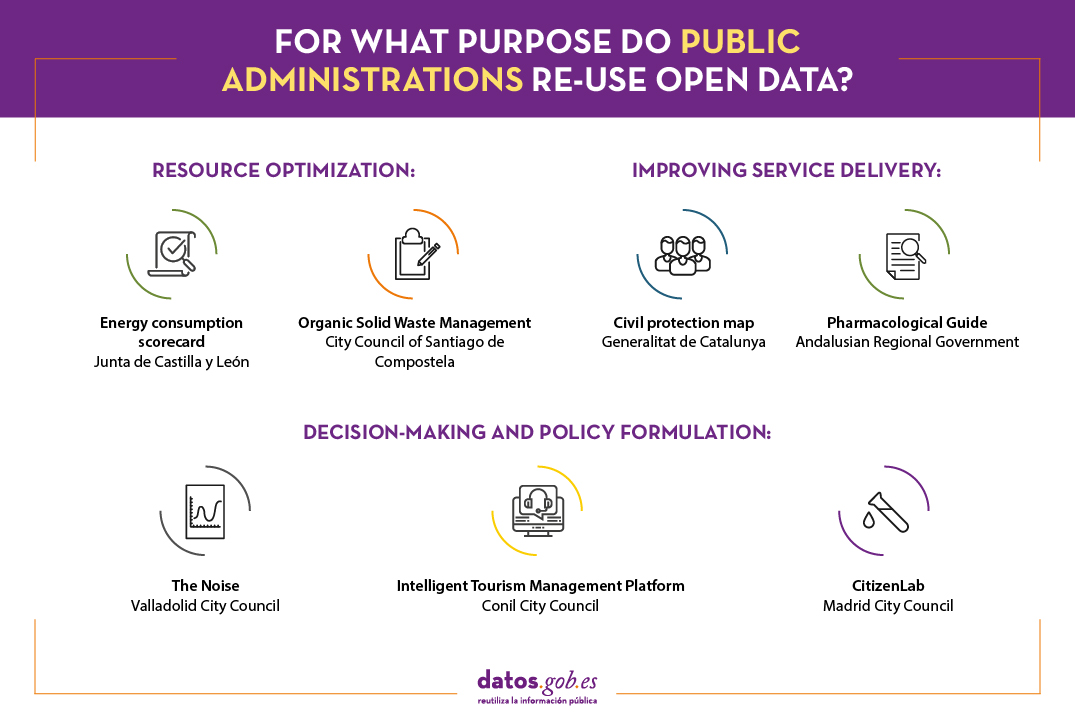
Undoubtedly, there are numerous applications and digital tools used by public administrations - and it seems that there will be more - that base their operation on open data to offer more and better services to citizens. In this article we have compiled some examples, but if you know of any related ones that may be of interest, do not hesitate to leave a comment or write to us at our email address dinamizacion@datos.gob.es.
Content prepared by the datos.gob.es team.
On 23, 24 and 25 November, the first edition of EU Open Data Days will take place, which can be followed online. Organised by the Publications Office and the Presidency of the Council of the European Union, the aim of the event is to promote open data, showing the value of the different business models based on them.
The event will be divided into 3 days: the first two days will be dedicated to the EU DataViz 2021 conference, focusing on open data and data visualisations, while the last day will be dedicated to the final of the EU Datathon 2021.
EU Dataviz 2021
The EU Dataviz 2021 conference will feature experts addressing techniques and best practices related to open data and its reuse in both the private and public sectors.
The content of the event has been built collaboratively. Between March and May this year, citizens from all over the world had the opportunity to submit their thematic proposals to participate as speakers. From the more than 150 proposals received, the EU DataViz 2021 Programme Committee selected the ones chosen to form the final agenda, which will take up two days.
23 November 2021: Open data
La primera jornada arrojará luz sobre los datos abiertos como base de soluciones que den forma al futuro digital de Europa.
The first day will shed light on open data as the basis for solutions to shape Europe's digital future.
It will be opened by the Director-General of the Publications Office of the European Union. Xavier Bettel, Prime Minister of Luxembourg, will follow with a presentation on data and digitisation at the heart of Luxembourg's innovation. This will be followed by a plenary session - with 30-45 minutes talks showcasing best practices, new use cases and emerging trends - and three thematic sessions - 45-60 minutes, with a more practical focus-:
- Plenary session. It will address the EU's data strategy and its path towards a single European market, as well as the situation of open data in Europe. There will also be a round table dedicated to data intelligence and its conversion into informed decisions. The Spanish side will be presented by Nuria Oliver, Co-Founder and Vice-President of ELLIS - European Laboratory for Learning and Intelligent Systems (Spain), who will talk about Valencia's experience in using data science in the fight against COVID-19.
- Thematic session 1: Creating open data ecosystems. Examples of projects contributing to open data policies, such as the European water health open knowledge (WHOW) project, will be showcased.
- Thematic session 2: Data for people. The importance of citizen participation and user-oriented projects in the field of open data will be highlighted. Among the projects to be showcased, we highlight the presentation by Antonio Ibáñez, Head of Transparency and Re-use of Information of Castilla y León, who will talk about transparency and open data in the health service of the region.
- Thematic session 3: Facilitating data reuse. Focusing on the enablers of open data, such as FAIR principles, digital literacy or mechanisms to ensure interoperability.
24 November 2021: Data visualisation
This conference will address the importance of communicating data efficiently. It will provide good practices and techniques to build data narratives and ensure better service to citizens.
After the opening by Boštjan Koritnik, Minister of Public Administration of Slovenia, representing the Presidency of the Council of the European Union, plenary and thematic sessions will also take place.
- Plenary session. It will consist of three presentations "Data visualisation as a vector of innovation: the case of lawyers", " Applying diverse, equitable and inclusive awareness in data visualisation" and " Opening EU climate open data through data storytelling".
- Thematic session 1: From open data to data visualisation. This session will serve as a bridge between open data and data visualisation. It will discuss storytelling and empowering citizens to turn open data into insights, among other issues.
- Thematic session 2: Serving citizens with dataviz. It will focus on how to involve citizens' needs in the process of creating visualisations and will offer concrete tips, for example for data visualisations on mobile phones.
- Thematic session 3: Using dataviz for policy making. It will show how data visualisation can support the decision-making cycle, with a particular focus on the EU public sector.
EU datathon 2021
The EU Datathon 2021 final will take place on 25 November. The nine finalist teams will present their solutions to the jury, which will evaluate each proposal and determine the final classification in the different categories. Among the finalists is Spain's CleanSpot, an app that seeks to encourage recycling through gamification.
The thematic challenges will be presented by a panel of experts and the event will close with an awards ceremony.
How can I attend?
Registration is free of charge. The different presentations can be followed online, but registration is required. Register and discover the latest trends and use cases of open data!
Did you know that opening information in sectors such as housing can help you find your new home? Moving house is not usually an easy decision and some doubts may arise, such as whether it is more profitable to buy or rent, what services are available in each neighbourhood of the city or what is the approximate price of housing on the market.
The data provided by public bodies can help us find answers to these and many other questions. This data can be used to create tools and applications that, in a simple and user-friendly way, allow us to compare parameters and make better decisions, some of which we have already collected in a previous article. On this occasion we update the information including 10 new use cases, offered by public and private organisations, which can offer you information of interest to find your new home.
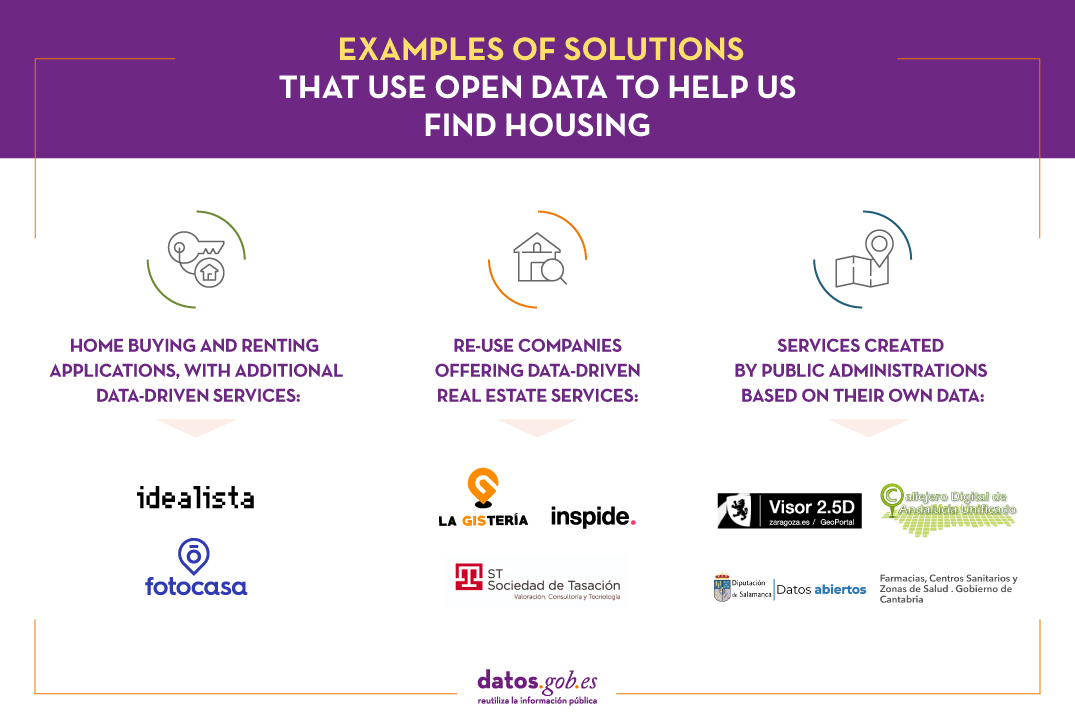
Home buying and renting applications offering additional data-driven services
There are currently numerous digital tools and applications that provide users with information about property listings for sale or rent. Some of these companies also offer additional services based on data that provide a better understanding of the market. Let's look at two examples.
- Idealista. In Idealista, users can find an analysis based on data from the real estate market in Spain, Portugal and Italy. To do so, they use data from both public sources (for example, from the Cadastre, the National Geographic Institute or the INE) and private sources from the idealista.com portal itself. It also has a set of technological tools - including the possibility of accessing the platform's data through an API - and information analysis tools to process, homogenise and structure useful data sources and transform them into easily accessible information. An example is the map of average sales price per square metre or its prediction of how much solar energy could be generated by all the municipalities in Spain.
- Fotocasa. This platform provides users with interactive maps with data from its Real Estate Index to know, in real time, the sale and rental price per m2 according to the supply of homes that are advertised on the real estate portal. Fotocasa encourages the use of open data, making it possible to use this valuable data to measure the market.
Re-use companies
In the market we also find companies specialised in data reuse, which exploit their potential to create services of interest in the real estate field. Some examples are:
- La Gistería. This consultancy company specialises in data visualisations using GIS technologies. Together with Geomarketing inmobiliario de Madrid, they have created 27 maps delimited by zones, positioning the points of interest in different areas such as health, leisure, or education. These maps have been created using the open data of the Madrid City Council and the brand identity of the real estate company Engel & Volkers in order to integrate it into their website and facilitate the search for a flat by users.
- Inspide. Through a web application, it allows to know if a city like Madrid adapts to the requirements of social distancing derived from the current pandemic situation and what urban actions could solve this problem. Inspide shows, for example, the width of the pavements represented with colours, and specifies whether their width is adequate to maintain the required distance between pedestrians. This is a very interesting application if we want to find a wide neighbourhood with wide streets in which to buy our next home.
- Sociedad de Tasación. This is an independent appraisal company that offers valuations of all types of assets, especially real estate assets. It offers valuation, consultancy and technological services, such as the use of Big Data and Artificial Intelligence applied to the Real Estate Sector. To implement its services, it uses its own data as well as public data from the Cadastre, the statistical portal of the Registrars, or the General Council of Notaries.
Services created by the public administrations themselves based on their data
It is not only private companies that create solutions based on open data. Local councils and public bodies also provide their citizens with applications and digital tools that show open information of interest when deciding, for example, on the location in which to buy a new home.
- Interactive Viewer of Zaragoza. Zaragoza City Council, through its geoportal, has included an interactive viewer that allows you to see the city's buildings and the shadows they cast on the streets. This new virtual map is accessible to all citizens. The interactive viewer offers an innovative vision of the city that can be of help if we want relevant information about the orientation and exposure to the sun that a certain area of Zaragoza has.
- Digital street map of Andalusia. It allows the search of postal addresses in all the municipalities of Andalusia using the information of roads and portals of the CDAU project (Unified Digital Street Map of Andalusia). It is also possible to locate other points of interest, in addition to postal addresses, using data from the DERA product (Spatial Reference Data of Andalusia). If you are thinking of looking for an area that meets the characteristics you need to buy or rent a property in Andalusia, this application can help you.
- Network of Crecemos centres in the province of Salamanca. The open data portal of the Provincial Council of Salamanca offers through its website public information on the Crecemos network of centres in the province of Salamanca. This network is part of the 'Crecemos' programme of the Junta de Castilla y León, which facilitates work-life balance in rural areas, as well as helping to generate employment and fix the population in the area. Among other information, it analyses the places where it is easier to reconcile work and personal life, which is very useful for users to know where to buy a house. The portal offers the possibility of downloading this data in various formats, such as XSLX, CSV or XML.
- Pharmacies, Health Centres and Health Areas. How many pharmacies and health centres are there in the area where you want to buy your new home? How far are they from your location? This service shows the health map of Cantabria to offer its users data about the location of pharmacies and hospitals in each area of the autonomous community.
Undoubtedly, there are numerous digital tools and applications that base their services on open data to offer information about the real estate market to their users. If you know of any other tool based on open data that you think may be of interest to us, do not hesitate to leave us a comment or send us an email to dinamizacion@datos.gob.es.
Content prepared by the datos.gob.es team.
Mobility is a key economic driver. Increasing the efficiency and quality of a country's mobility system contributes both to the strength of its economy and to improving the quality of life of its citizens. This is particularly important in the mobility systems of cities and their metropolitan areas, where most of the population and, thus, most of the economic activity is concentrated.
Aware of this - and because we citizens demand it - local authorities have for decades allocated a significant part of their annual resources to expanding, improving and making their transport and mobility networks more efficient.
In the last decade, open data has been one of the most important vectors of innovation that have been introduced in the mobility strategies developed by cities, giving rise to initiatives that would have been difficult to imagine in previous periods. Despite all the complexities involved, opening both static and real-time mobility datasets for reuse is actually cheap and simple compared to the cost of building a new transport infrastructure or the cost of acquiring and maintaining the operational support systems (OSS) associated with mobility services. In addition, the existence of an increasing deployment of sensor networks, accessible through control systems deployed in the context of "smart city" strategies, makes the task a little easier.
We should not forget, moreover, that public transport is key to tackling climate change as it is one of the fastest growing sources of greenhouse gas emissions, and public transport offers the best mobility solution to move people quickly and efficiently in cities around the world. As shown in the figure, simply shifting passengers using their private vehicles to public transport has a major impact on reducing greenhouse gas emissions. The Bus Industry Confederation estimates that shifting passengers from cars to public transport can lead to a 65% reduction in emissions during peak hours. This reduction could be as high as 95% in emissions during off-peak hours for those commuters who switch from private cars to public transport.
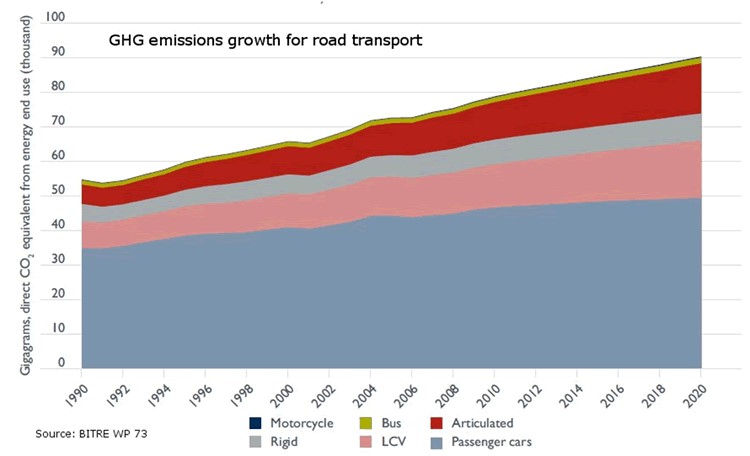
For all these reasons, there are already numerous examples where freeing up transport and mobility data to put it in the hands of travellers is proving to be a policy with important benefits for many cities: it allows better use of resources and contributes to more efficient mobility in urban space.
Let's look at some examples that may not be as well-known as the ones that usually reach the media, but which demonstrate how the release of data allows for innovations that benefit both users and, in some cases, the authorities themselves.
Redesigning New York City bus routes
All cities are constantly thinking of ways to improve their bus routes in order to provide the best possible service to citizens. In New York City, however, the open data policy, as an unplanned consequence, provided an important aid to the authorities, based on the analysis of data from the bus network users themselves.
The rider-driven Bus Turnaround Coalition campaign, supported by TransitCenter, a foundation working to improve public transport in US cities, and the Riders Alliance, is using open data to raise awareness about the state of New York City's bus network, proposing solutions for improvement to the Metropolitan Transportation Authority (MTA).
To formulate their recommendations, the organisations analysed bus arrival times using the MTA's own location maps, incorporated real-time data through the GTFS specification, reviewed ridership data, and mapped (and optimised) bus routes.
Among the most innovative proposals is the shift in approach to route design criteria. Instead of trying to cater to all types of travellers, the Bus Turnaround Coalition, after analysing how people actually move around the city and what type of transport they would need to achieve their goals efficiently, proposed the following recommendations:
- Add lines to take passengers from the outskirts of the city directly to the underground lines, facilitating a quick trip.
- Improve lines to offer short, fast routes within a neighbourhood for people who want to run a quick errand or visit a close friend.
- Split routes that are too long to minimise the risk of delays.
- Readjust the distance between stops, which are often too close together, complementing gaps in metro coverage.
Open data has turned frequent rider protests and complaints about poor network performance into a set of reasoned, data-driven inputs, which have been captured in a series of MTA commitments to improve New York's bus network, such as redesigning the network by 2021, increasing journey speeds by 25%, and proactively managing bus maintenance.
Bicycle usage data in San Francisco
Like many other cities, San Francisco, through its Municipal Transportation Agency (SFMTA), records travel data from users of its public bike-sharing system and makes it available as open data. In this case, the transport authority itself publishes regular reports, both on the overall use of the system and on the conclusions it draws for the improvement of the city's own mobility.
By documenting and analysing the volumes and trends of bicycle use in San Francisco, they are able to support the goals of the SFMTA's Strategic Plan, which aims to prioritise other forms of travel in the city than the private car.
For example, ongoing analysis of bicycle passenger volumes at key intersections in the city and citizen input has reduced traffic congestion and accidents by re-prioritising vehicle traffic priorities according to actual roadway usage at any given time of day.
Efficient parking in Sacramento
Many cities try to address traffic congestion problems from different perspectives including efficient parking management. Therefore, one of the datasets frequently published by cities with open data initiatives is public parking occupancy.
In the city of Sacramento, California, the open data initiative publishes datasets from the citywide sensor network that monitors parking availability at parking meters and not only in the city's public car parks. In this way they have managed to reduce emissions as vehicles spend less time looking for parking, while significantly improving traffic flow and the satisfaction of citizens using the Sacpark app.
In 2020, due to the pandemic, passenger transport around the world was drastically reduced due to the mobility restriction policies that governments around the world had to deploy to curb the spread of the virus, as seen in the image below.
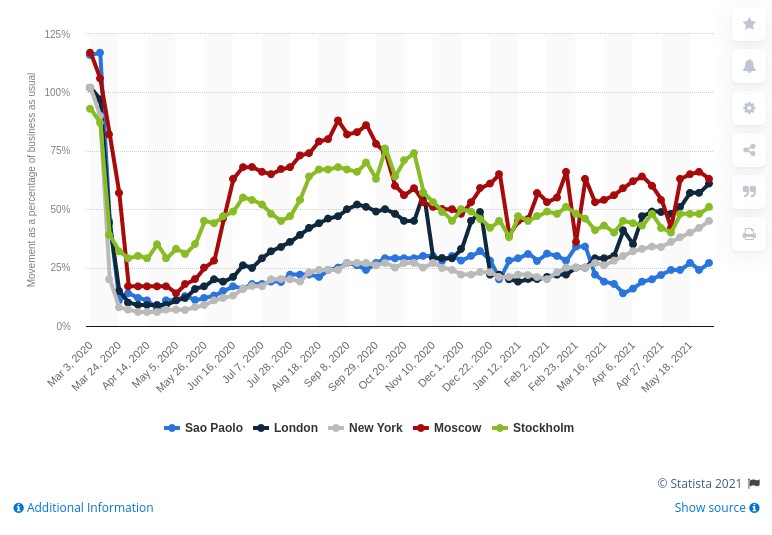
In June 2021 cities are still far from recovering the levels of mobility they had in March 2020, but we continue to make progress in making data the basis on which to build useful information, and essential in the new innovations coming through artificial intelligence.
So, as the pandemic recedes, and many initiatives resume, we continue to see how open data is at the heart of smart, connected and environmentally friendly mobility strategies.
Content prepared by Jose Luis Marín, Senior Consultant in Data, Strategy, Innovation & Digitalization.
The contents and views reflected in this publication are the sole responsibility of the author.
The University of Alicante will host the International Congress on Open Data and Reuse of Public Sector Information. The event will focus on the role of open data and its potential reuse to achieve improvements in several key areas for our country, such as tourism and the economy. It will also address the analysis and legal implications of Directive (EU) 2019/1024 of the European Parliament and of the Council of 20 June 2019 on open data and the re-use of public sector information.
This conference is part of the Project "Challenges of the Ministry PID2019-105736GB-I00DER: Open data and reuse of public sector information in the context of its digital transformation: adapting to the new regulatory framework of the European Union", whose principal investigators are Julián Valero Torrijos and Rubén Martínez Gutiérrez, and the Transparency Agreement between the University of Alicante and the Department of Participation, Transparency, Cooperation and Democratic Quality 2021.
Timetable and agenda
The Congress will take place on 23 and 24 September 2021 in online and face-to-face mode.
The opening will be given by Rosa Pérez Garijo, Councillor for Participation, Transparency, Cooperation and Democratic Quality of the Generalitat Valenciana, and Amparo Navarro Faure, Rector of the University of Alicante.
Next, Kiko Llaneras will be in charge of the inaugural conference with his speech "Open data and the reuse of public sector information: experiences from practice". Kiko Llaneras is known for his articles on data journalism in El País, where he analyses certain aspects of political, social and economic current affairs based on indicators, statistics and surveys, among other data sources.
The congress will then be based on 4 round tables, titled:
- Open Data in Tourism
- Contracting and the economic value of data
- Open Data and the Environment
- Comparative Law. Open Data and RISP in the EU context.
Each of these round tables will be attended by experts and professionals from the public, private and academic sectors. You can see the full programme here (only available in Spanish).
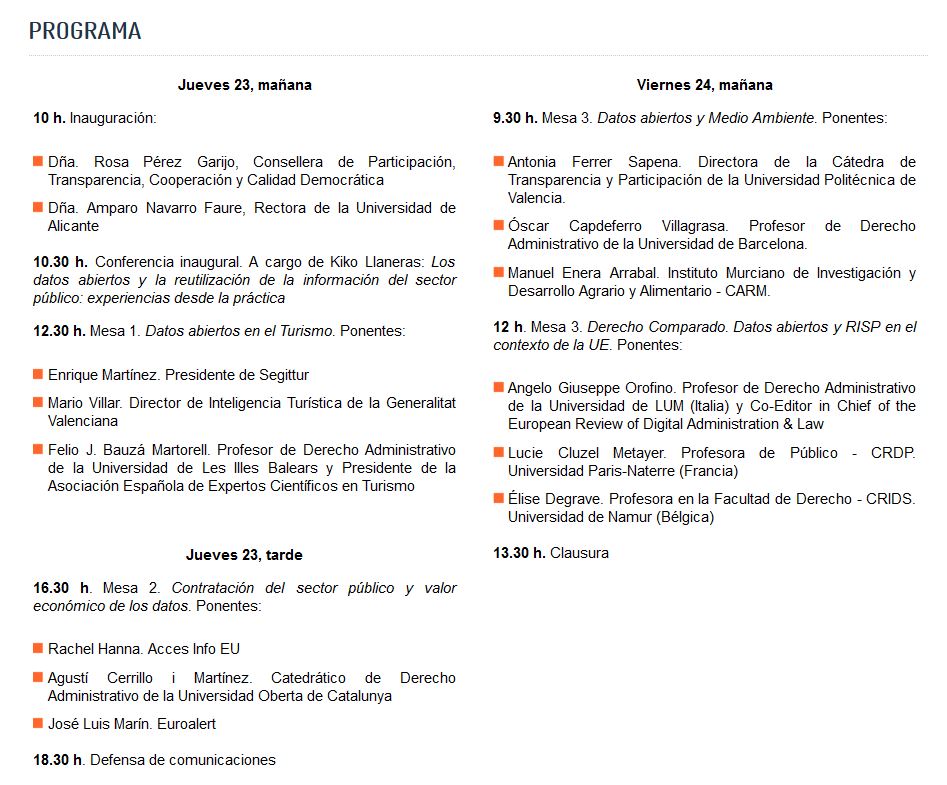
Do you want to participate in the Congress? There is still time to send your papers
The Congress is open to the participation of citizens and companies that want to share their knowledge and experience. Proposals related to the four round tables can be submitted, although free themes will also be accepted as long as they are in line with the objectives of the congress.
Papers must be submitted before 15 July using this form. The application consists of an abstract of a maximum of 400 words detailing the proposal. On the 21st of the same month, the organisers will send notification of acceptance of the papers, which must be defended publicly.
How to attend?
The event is free of charge, but places are limited. In order to attend, this form must be completed before 20 September 2021 at 23:59 hours. Admitted participants will receive confirmation of their registration by email.
When pre-registering, you must indicate whether you wish to attend in person or virtually. Those who choose the online option will receive an email with the link to the video call platform.
If you have any questions, you can write to cursos.deje@ua.es for administrative matters and to ruben.martinez@ua.es for academic matters.
After months of work, the 3rd Aporta Challenge has come to an end. Under the slogan "the value of data in digital education", this year's competition sought solutions that used open data to drive improvements in the education sector.
The competition, organised by the Aporta Initiative, launched by Red.es together with the Secretary of State for Digitalisation and Artificial Intelligence, began in October 2020, with a first phase consisting of an ideas competition. After the jury's assessment, 10 finalists were chosen and have had three months to transform their ideas into a prototype. These prototypes were presented on 22 June in an online session.
10 proposals that stand out for their quality
The 10 papers presented are a great example of the power of open data to transform the education sector, improving its effectiveness and efficiency. The need for universal access to knowledge through inclusive and quality education has become even more evident in the current pandemic context. Open data can help to meet this challenge. Open data can be analysed and used to shape solutions that help to improve the student experience in the learning process, for example through personalisation of education, identification of behavioural problems or informed decision-making, among other issues.
All the entries were of a high quality, reflecting the efforts of all the finalist teams. The jury, made up of experts representing companies, public administrations and organisations linked to the digital economy and the academic world, had a difficult time choosing the three winners. In the end, the three winners were UniversiDATA-Lab, MIP Project and EducaWood, who received prizes of €4,000, €3,000 and €2,000 respectively.
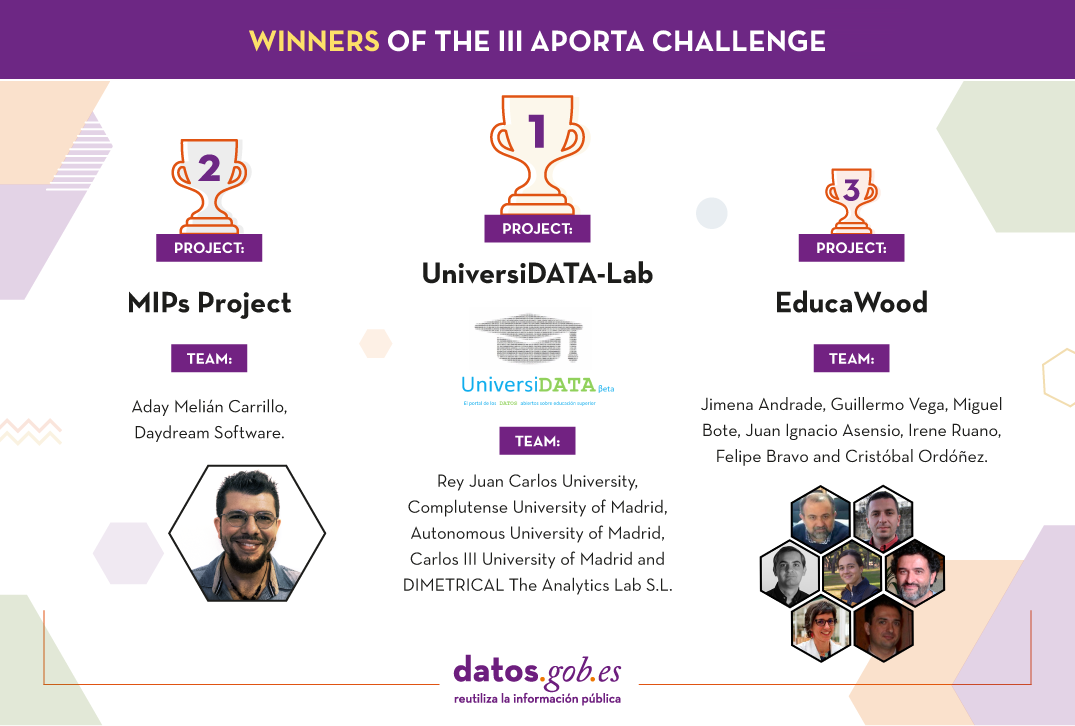
First prize: UniversiDATA-Lab
-
Team: Rey Juan Carlos University, Complutense University of Madrid, Autonomous University of Madrid, Carlos III University of Madrid and DIMETRICAL The Analytics Lab S.L.
The first prize went to UniversiData-Lab, a public portal for the advanced and automatic analysis of datasets published by universities. It is a complementary project to UniversiData: while the objective of UniversiDATA is to facilitate access to high quality university datasets with standard formats and criteria, the objective of UniversiDATA-Lab is to enhance the value of these datasets, carrying out advanced and automatic analysis of them, taking advantage of the homogeneity of the content.
UniversiDATA-Lab offers a catalogue of applications created thanks to the application of advanced analysis and visualisation techniques, carried out in R language. In the online session they showed the analysis of interurban commuting, the analysis of CO2 generated by student commuting and the analysis of gender differences in the different university branches.
These analyses can be instrumental in helping universities to make decisions related to administration and management, with major benefits for the environment, the economy and society.
Screenshots of UniversiDATA-Lab
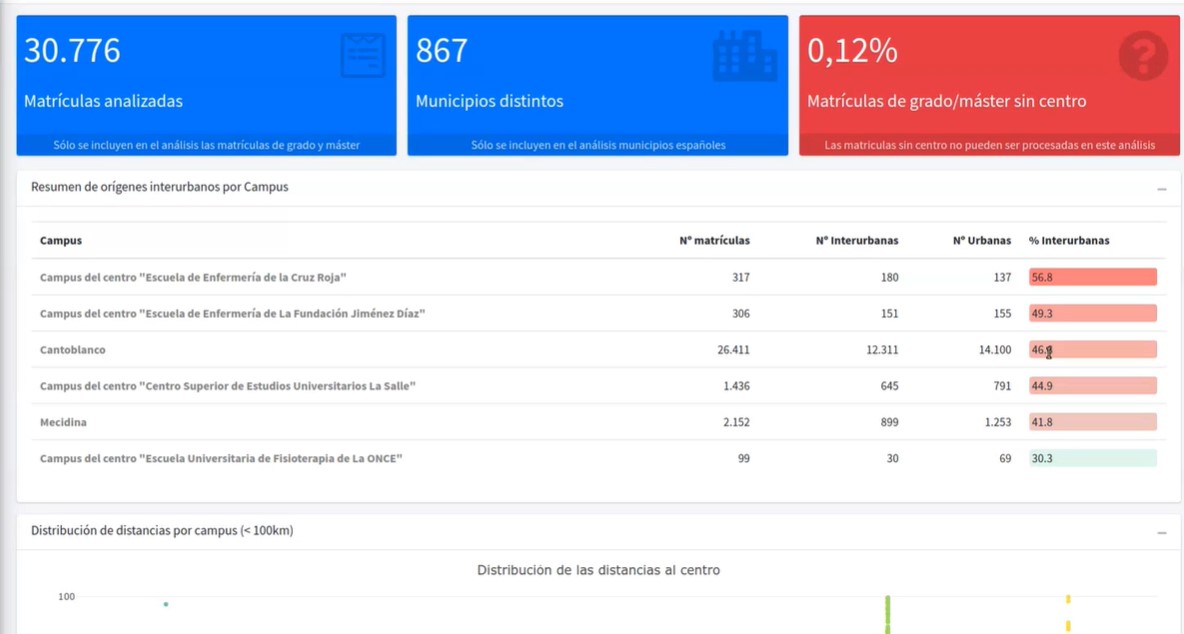
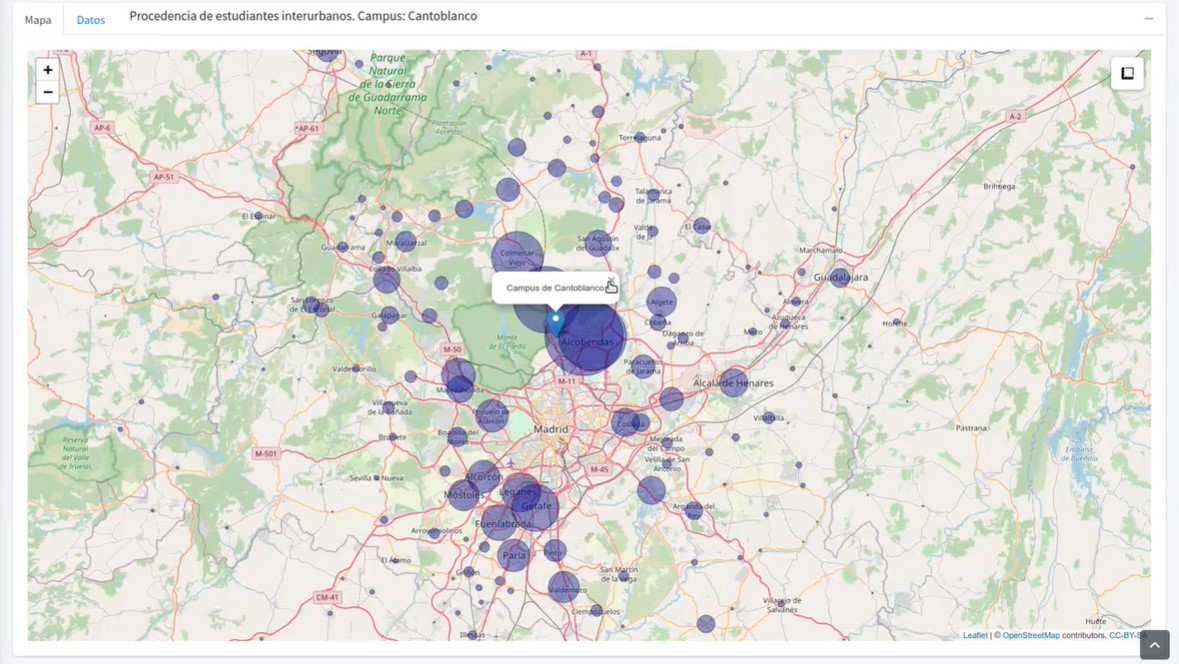
Second prize: MIP Project
- Team: Aday Melián Carrillo, Daydream Software.
MIP Project, the second prize winner, is an online service where any user can register and start creating MIPs (Marked Information Pictures). A MIP is an information format consisting of a series of interactive layers over static images that facilitate the retention of information and the identification of elements.
The prototype includes a Python converter from GeoJSON open data to the format needed to develop interactive atlases. It also offers a public cloud of freely accessible MIPs for consultation, study or independent learning.
Thanks to this tool, teachers can create MIPs quickly and easily by manually drawing regions of interest on any image imported through the web. A more enjoyable way to educate and to attract students' attention more easily.
Screenshots of MIP Project
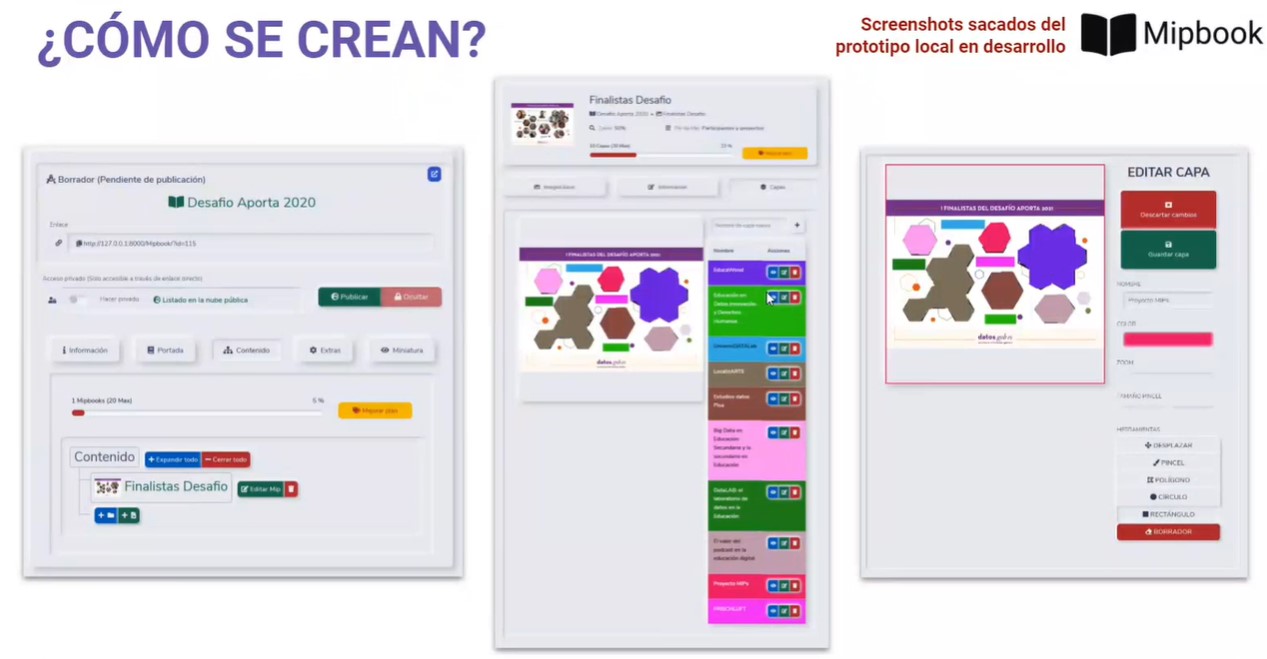
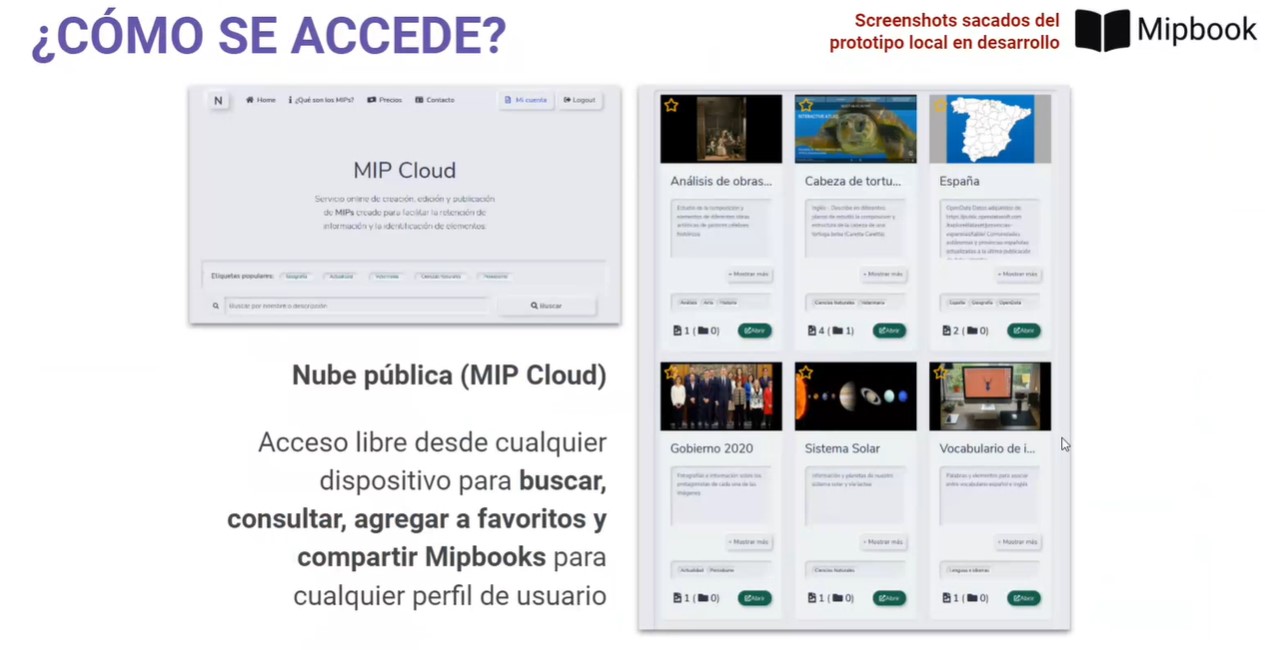
Third prize EducaWood
-
Team: Jimena Andrade, Guillermo Vega, Miguel Bote, Juan Ignacio Asensio, Irene Ruano, Felipe Bravo and Cristóbal Ordóñez.
EducaWood is a socio-semantic web portal that allows you to explore the forest information of an area of Spanish territory and enrich it with tree annotations. Its aim is to promote environmental learning activities, one of the main aspects of UNESCO's "Education for Sustainable Development Goals", which is part of the Spanish Government's Agenda 2030.
Thanks to the use of EducaWood, teachers can propose activities that students can carry out either face-to-face or online (through virtual field visits). In the face-to-face modality, students visit natural areas and make annotations of trees, such as location and identification of species, measurements, microhabitats, photos, etc. These annotations become available to the whole community as open data, thus enabling the application to be used remotely. These data are also enriched with other sources such as the Spanish Forest Map, the National Forest Inventory, GeoNames or DBPedia.
EducaWood helps students to learn more about their environment, while promoting ecological awareness.
Screenshots of Educawood
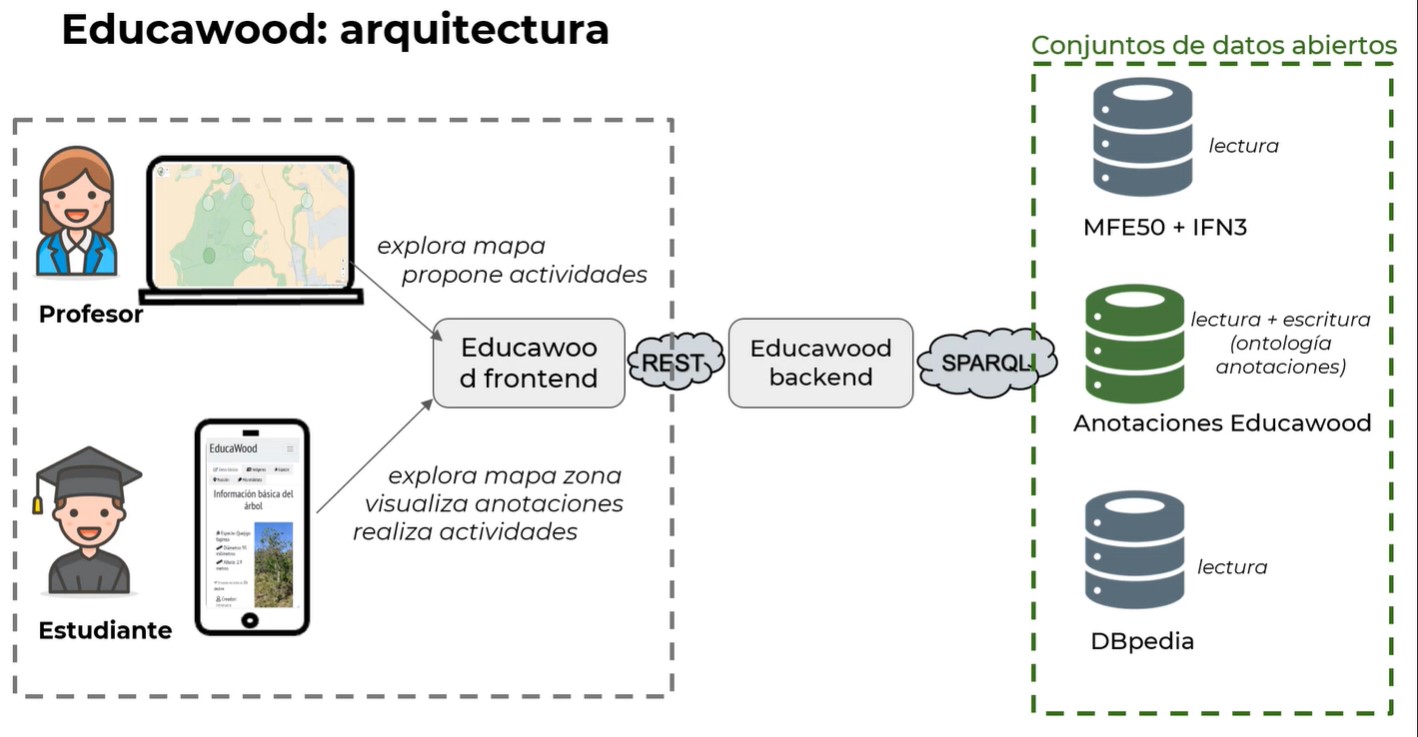
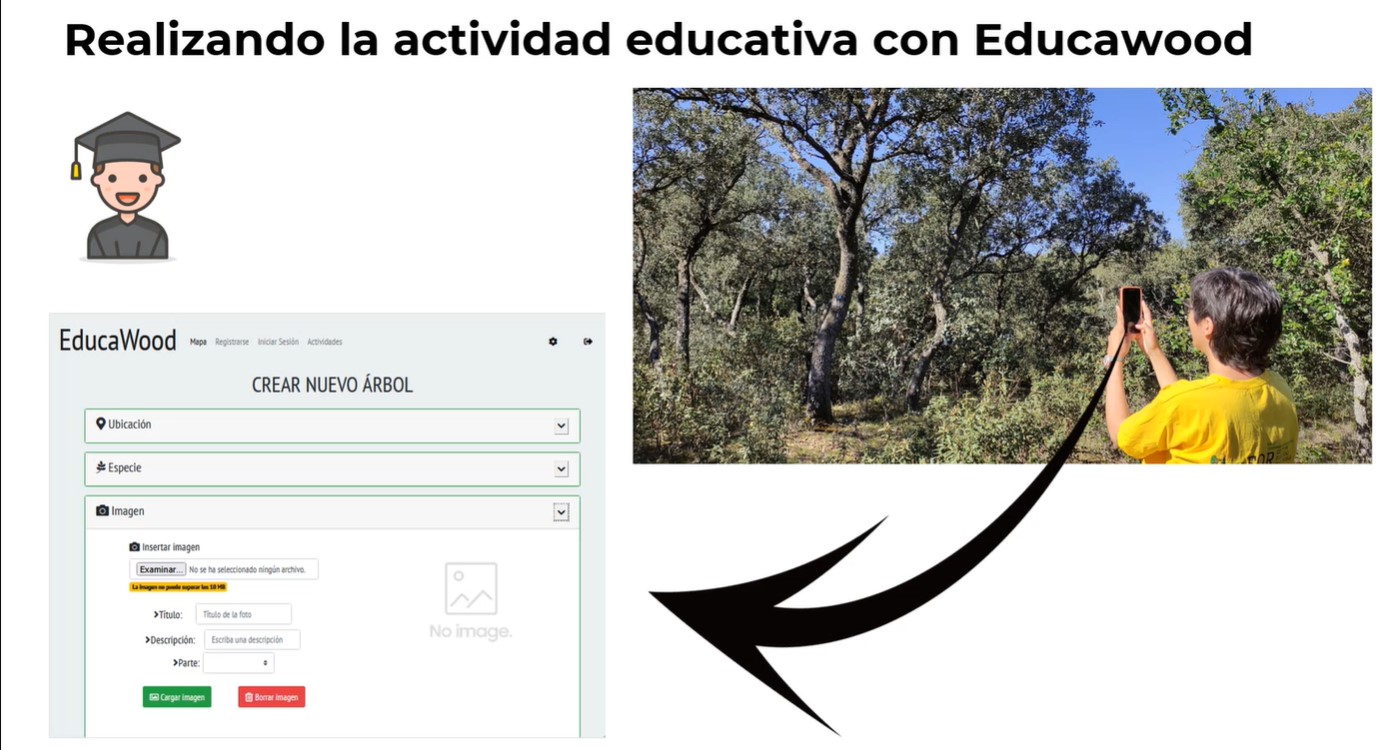
Alberto Martínez Lacambra, Director General of Red.es, presents the awards
The awards to the three winners were announced on 8 July at a ceremony held at Red.es headquarters.
The three awards were announced by Alberto Martínez Lacambra, Director General of Red.es, who highlighted education as a key element in the evolution of a society marked by the pandemic, as well as the need to work to reduce the digital and social divide that still exists. He thanked all the participants for their participation, highlighting the quality of their work.
The event was attended by several members of the jury, who were able to talk to the three winning teams.
In the following video you can see how the event took place. Photos are also available on our Flickr account.
At datos.gob.es we are already working to shape the IV Aporta Challenge, which we hope to announce in the coming months.
Spring is coming to an end to give way to summer, holidays and warm weather. As with every change of season, for the Aporta Initiative it is time to review what has happened in the open data ecosystem over the last three months.
Boosting data strategies
During this season we have seen several initiatives, both local and statewide, launch processes to update their data strategies:
- In April, Málaga City Council presented a Municipal Open Government Plan that includes initiatives to promote open data. Specifically, the development of information campaigns, the homogenisation of dataset formats and the progressive incorporation of new datasets, also including data external to municipal management.
- The Community of Murcia launched a survey aimed at companies in the region to find out which datasets are of interest to them, with the aim of assessing their incorporation into the region's open data catalogue.
- The Government of Asturias carried out a participatory process to develop a Public Governance Strategy. Among other aspects, it aims to implement mechanisms to facilitate participation and access to open data.
- The Ministry of Economic Affairs and Digital Transformation has launched a consultation to identify proposals for the integration of Artificial Intelligence in the value chains of different sectors of the economy. All this within the framework of the National Artificial Intelligence Strategy.
The commitment to open data by Spanish public bodies is also evident in the growing support for the International Open Data Charter. Spanish representation in the Open Data Charter has grown this spring: two autonomous communities, Asturias and Valencia, and one local authority, the City Council of Pinto, agreed to join.
New portals and open datasets
In addition to the bloom, spring has also brought us new open data sharing platforms:
- Alcalá de Henares Town Council has developed a new Transparency and Open Data Portal to facilitate access to information and promote transparency in its management.
- A new version of Euskalmet, the meteorological service of the Basque Country, has also been launched. The portal includes an API Rest for reusers.
- The Spanish Patent and Trademark Office has presented a new version of its Open Data portal in a new format. Through it, users can access reusable data of all types of Industrial Property, available in PDF, XML or SGML formats, among others.
Other existing portals have opted to incorporate new tools:
- The Territorial Information Service of the Balearic Islands (Sitibsa) has launched a tool to automatically incorporate open data from its portal to the map service of the Spatial Data Infrastructure of the Balearic Islands (Ideib).
- The National Centre for Geographic Information (CNIG) has published the web application 'Mapa a la Carta', which allows to customise topographic maps.
- GeoPamplona, the geographic information system developed by the city council, has incorporated new features to improve the user experience and make the service more accessible to citizens. One example is its new catalogue of maps with information already selected, so that the user does not have to search for it.
- Zaragoza City Council has created 'Mis mapas, mis datos', a tool for creating simple and complex maps, combining various data sources.
Moreover, as usual, the vast majority of open data initiatives have been updating their data on a regular basis. Some of the new features that have been presented in recent months are the cultural heritage maps of each municipality on the Barcelona Provincial Council portal or the data on the state of the Mar Menor on the Murcia portal.
Events and training materials are growing
During these months we have attended many events and webinars related to open data. Some of them have been recorded and are available for viewing at any time:
- A few days before the arrival of spring, in March, there was the conference "Data in Local Administrations 20/30. Experiences and Challenges", organised by Alcobendas City Council, the Institute for Knowledge Transfer in Public Innovation (ITCIP) and the Innovation Club, with the support of the FEMP (Network of Local Entities for Transparency and Participation), the Spanish Network of Smart Cities - RECI and Oracle. The different sessions can be viewed here.
- On 23 April, a round table was held, within the framework of the Master in Technology and Digital Innovation in Engineering of the UNED, on "Big Data and datos abiertos applied to mobility". If you missed it, you can watch it on Youtube.
In addition, some courses, guides and books have been launched for those who want to broaden their knowledge of new technologies and data:
- The central government has launched the Elements of AI project in Spain. This is a free online course aimed at all citizens that offers training in the basic fundamentals of Artificial Intelligence.
- Castilla y León has presented the 'Digital transformation guide for public employees', which has a section dedicated to open data. It explains what open data is, talks about the National Open Data catalogue (datos.gob.es) and highlights the importance of reusing information in the public sector.
- The Geomatics and Surveying Engineering Forum of the IDEE Working Group publishes a new version of the book 'Spatial Data Infrastructures', which emphasises the publication and description of spatial datasets by means of services. Among other issues, it includes how they should be presented through viewers and catalogues for their management and exploitation.
Re-use of data by public administrations and citizens
The impact of open data has also become evident in recent months thanks to multiple examples. On the one hand, we have a number of public administrations that have taken advantage of the value of data to implement projects that improve their efficiency and the service they provide to citizens:
- The Madrid Tax Agency has launched a project to use Big Data and Artificial Intelligence to fight municipal tax fraud. A Tax Laboratory will lead this strategy by incorporating information from the City Council's Open Data Portal.
- The Provincial Council of Valencia starts the project 'Connecta València: tourist, intelligent and sustainable territory', which analyses tourist data to adapt and improve the experience in all its municipalities.
- Barcelona City Council has promoted the pilot project 'Dades x Comerç', developed by BCNOpenData to help small businesses make decisions and better understand customer behaviour based on open data.
On the other hand, companies and entrepreneurs have used data to create products, for example:
- The elections to the Community of Madrid left us with multiple examples of journalistic pieces developed based on open data, such as these from El Pais o eldiario.es.
- Two people from Bilbao have created CityAr, an app where users can organise routes, participate in events or play games through augmented reality. CityAr uses Bilbao's open data to show the city's cultural and leisure offer.
In this period, the call for two awards aimed at re-users has also been announced:
- The Asedie Awards 2021, for companies, institutions and open data projects that can contribute social and/or economic value. The deadline for applications is 15 September 2021.
- The new edition of the open data competition organised every year by Castilla y León, aimed at journalists, teachers, students or data reusers. Those interested in participating must send their proposal before 13 July.
A couple of global developments
At the international level, one of the main developments has been the launch of the new European data portal, data.europa.eu, which is positioned as a single access point for data from all over Europe. Its development and management for the next 6 years has been awarded to a consortium comprising, among others, the Ontological Engineering Group of the Polytechnic University of Madrid.
For its part, Asia has launched its first official portal that will bring together open data published by institutions, agencies and organisations from the different countries that make up the continent.
With these examples, it is clear that the open data ecosystem does not stop and continues to evolve month by month. If you want to share any other news that you consider of interest, we invite you to tell us your opinion in the comments section.
We recently reflected on the rise of data journalism in the media, a discipline that is becoming increasingly important. Through technologies and tools linked to data, this journalistic modality makes it possible to offer readers more documented, attractive and comprehensible information. To this end, data journalists perform actions such as interpreting municipal budgets, combining statistics and financial reports or exploring geospatial information to tell stories based on large amounts of data.
Here, we want to highlight the role that data journalism plays in serving as an impetus for the creation of new companies, associations and user groups that reuse data to boost the economy or drive accountability.
Next, we will analyse how the reuse of data, within the field of journalism, has favoured the emergence of new business models, non-profit organisations and transparency, research or political fact-checking activities in which data journalism is at the core of their business or daily activity.
Organisations involved in data journalism
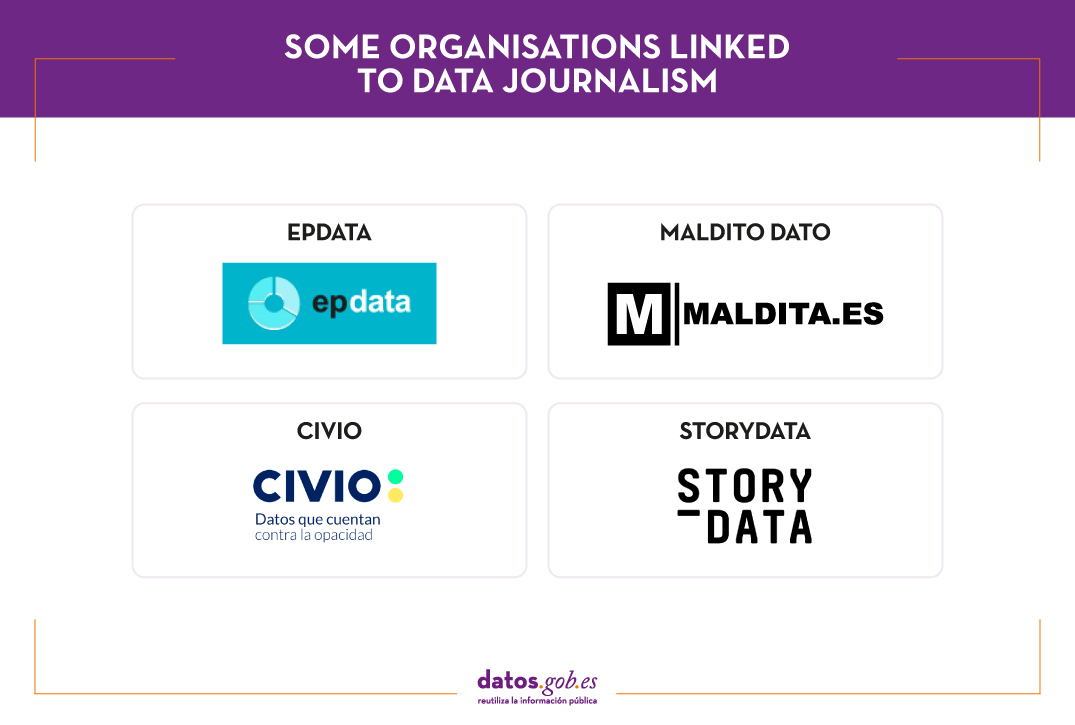
News agencies: EPDATA
EpData is the platform created by Europa Press whose main objective is to facilitate the use of public data by journalists to enrich the news through graphics, as well as to analyse the context and contrast the figures offered by the different sources.
This platform was created with the aim of transferring the spirit of a news agency to the world of data journalism. To achieve this, they have created an extensive data repository with all the statistics that are often reported in Europa Press, with more than 60 million data from public and private sources. Any user can consult them through this link.
EpData's activities linked to data journalism
This repository allows EpData to offer graphs, statistics and data visualisations related to current events on a daily basis. For example, over the last year they have been showing updated data on the current pandemic that other media and scientific publications have used for their news.
However, the range of topics they combine on their platform is very broad, as they offer statistics and graphs based on data on topics as diverse as employment, economic developments, society, politics, etc.
Fact-checking: Maldito Dato
According to its coordinators, "Maldito Dato is the project within the verification media Maldita.es in which data journalism, transparency, investigation and political fact-checking, i.e. the verification of political discourse, are carried out".
In other words, Maldito Dato is the section of Maldita.es that carries out data journalism, made up of specialists in this field. Among its main functions is the production of journalistic pieces based on data, political fact-checking and topics based on the use of the Transparency Law.
Maldito Dato's activities linked to data journalism
Open data is an important part of Maldito Dato's nature, both in terms of publishing and reusing it in its news. Some examples are:
- Map of coronavirus cases at the municipal level throughout Spain, developed based on data published by each autonomous community.
- Ministry of Health data on vaccination, using data published by the Ministry of Health, either in the form of open data or daily reports.
- In this other example, you can see how they use data from the Statistical Portal of the Government Delegation against Gender Violence to make various comparative graphs on the increase in the number of calls to 016. They have also made comparative graphs based on INE data or even CIS data.
In addition to using open data from public administrations, sometimes they publish open data themselves. For example, when they release databases obtained by requests for information through the Transparency Law. Some examples are the database of public information requests made by citizens on the Transparency Portal, the database of health inspections of swimming pools in Madrid or the database of Ministry of the Interior subsidies for 'catastrophic situations'.
Non-profit organisation: CIVIO
CIVIO is a non-profit organisation that promotes the transparency of institutions and that people can access public information through technology combined with journalism. To achieve this goal, it has three main lines of action:
- Journalism
- Public Advocacy
- Transparency services of public authorities
CIVIO's activities linked to data journalism
This organisation has recently published research on the use of emergency procurement during 2020. They have used the emergency contracts awarded during the past year that have been published on the Public Sector Procurement Portal and the platforms linked to the different autonomous communities. A search engine for emergency contracts can be found at this link and the main conclusions of the research can be found here.
At the end of this article, CIVIO explains the methodology used to carry out the analysis of this data, as well as the difficulties encountered in the process. The data used in this research have been made available to all users in Datos Civio in formats that facilitate their reuse. Thanks to this, several media outlets have used the CIVIO database to produce their own information.
Data analysis, visualisation and communication: STORYDATA
Storydata is an organisation of women experts in data research, analysis, visualisation and communication. They are characterised by offering a global communication service aimed at public and private entities that want to transform a set of their own or external data into a communicative story. To do so, they use a variety of media and formats, from the preparation of reports to the creation of campaigns and the dissemination of content on social networks.
Storydata's activities linked to data journalism
Open data is part of Storydata's DNA. Some of its most relevant projects are:
- The Data against noise project, which aims to combat opinions on male violence through open data.
- Collaboration in the data section of the Barcelona Metròpolis magazine of Barcelona City Council.
- Writing of dissemination articles on data in the dossier of the Associació de dones periodistes de Catalunya (Association of Women Journalists of Catalonia).
- Collaboration agreement with Blanquerna's Master's Degree in Data Journalism and Fact Checking.
- Training to multiple media, institutions and universities on data journalism and visualisation, such as the Escola de dades de Sentit Crític, the Master of Information Design and Data Visualisation of Elisava, Euromediterranean Institute (Euromesco), Juries and training pill in the Big data Challenger of Fundación la Caixa.
Currently, Storydata collaborates with media such as Crític, for example, creating a data visualisation that shows inequality in times of confinement or this one on how the coronavirus affects the different municipalities of Catalonia.
User groups and list of data journalists
If you are a data journalist, or are interested in the subject, you may be interested to know that there are different platforms where you can find user groups related to the reuse of data in the field of journalism.
- On LinkedIn, the “Periodismo de datos” group stands out, created so that interested parties and professionals in data journalism can contribute and share knowledge related to this discipline.
- On MeetUp, we find the user group “Periodismo y visualización de datos”. Organised by Adolfo Antón, it has more than 1,200 participants who interact in relation to the use of data for its reuse in journalism.
- Also on MeetUp is the “Madrid Abriendo Datos” group.
- Telegram or Slack groups: many users organise through Telegram (in groups such as postdata, periodismodatos and visualizar) or Slack (periodismodatos.slack.com).
On the web we can also find a list of communicators specialised in data in Spain and Latin America, made up of more than 300 journalists. This project brings together a series of professionals who see data as the true raw material of journalism. If you want to consult the complete list, you can do so through the following link.
This is just a sample of organisations, companies and user groups linked to data journalism. If you know of any others that may be of interest, do not hesitate to write us a comment or send us an email to dinamizacion@datos.gob.es.
Content prepared by the datos.gob.es team.
Data journalism is one of the disciplines that has grown the most in the media in recent years, both within and outside our borders. This form of journalism consists of collecting accurate data, analysing it and making it available to the public through articles and/or graphic and interactive resources, facilitating the understanding of complex issues.
In datos.gob.es we have interviewed Adolfo Antón, designer, journalist, trainer and passionate about Free Software and open knowledge. Adolfo has been president of Open Knowledge Foundation Spain, coordinator of School of Data Spain, head of the Datalab at Medialab Prado, coordinator of the Data Journalism working group, of the Data Journalism Conference and curator of the Data Journalism (2014-2019) and Visualizar (2015-2018) workshops. He is currently coordinator of the Master's Degree in Journalism and Data Visualisation at the University of Alcalá and Professor of the Master's Degree in Digital and Data Journalism at the Nebrija University.
Full interview:
1. What does a data journalist do?
Thank you, first of all, for your interest in journalism and data visualisation and for what I can contribute to these fields. I appreciate and welcome the existence of datos.gob.es, an essential project that will soon be ten years old and which, paradoxically, I think is not sufficiently known, used and recognised in these fields.
To answer your first question, I am going to focus on what you have defined as data journalism, which begins with the collection of accurate data. There are currently many projects in the field of news verification and I see this, in my opinion, as a reaction to an exaggerated proliferation of false, manipulated news, hoaxes, lies and other faunas and floras of bad practices, not only journalistic but also communicative. The data we work with must be verified, certified, accredited and/or curated, providing context, source and methodology. Otherwise, we will develop flawed analysis and distorted stories.
There is a journalistic saying that goes "don't let a bad piece of information spoil a good headline", and in this temptation it is very important a strong journalistic ethics in journalists, editors and the media itself.
We need to verify, certify, accredit and/or curate the data we work with, providing context, source and methodology. Otherwise, we will develop flawed analyses and falsified stories.
Data journalism is essentially the use of computer applications to work with data, whether it is few, many or very many. Statistics, infographics and data visualisation are also important in data journalism.
With these IT tools, what Paul Bradshaw called the inverted pyramid of data journalism is realised:
- Compile (gather, collect).
- Cleaning (scrubbing, digging, investigating, interrogating)
- Contextualise (data and story context, methodology), and
- Combine (data, visualisations, infographics, maps, texts, interactives...).
It is therefore necessary to use IT tools and computer languages that cover one, several or all of the tasks in the work process. It is not mandatory, but it is advisable not to be cloistered in proprietary software, as this will determine the use we make of it. Third-party services can also be of great help, but it is preferable to use your own services that you have full control over
2. Why is data journalism important, and can you point us to any success stories or investigations where it has been key?
Data journalism is journalism that investigates with data and, therefore, is as important, necessary and primordial as journalism, if by this we mean critical and independent journalism, a fourth power in today's society. Not knowing how to work with data using IT tools limits us from doing good journalism, be it economic, political or sports journalism. Increasingly, data journalism is no longer the exceptional success story of generalist journalism, but the methodology of journalism in general.
The first cases of success in Spain can be circumscribed around Civio, an organisation that carries out data journalism in projects such as España en llamas, among others. Then, the projects that emerged around the conjunction of three elements that made data journalism grow in Spain are relevant:
- The Data Journalism group at Medialab-Prado, which awakens public interest in this discipline and enables the creation of an incipient community;
- The Unidad Editorial/URJC Master's Degree in Investigative Journalism, Data and Visualisation, which trains a first generation of data journalists;
- The media that are committed to it to a greater or lesser extent, such as El Español, El Mundo, El Confidencial, RTVE, El Diario de Navarra, eldiario.es or Ara.cat.
A high point in international data journalism, and also in Spain, was undoubtedly the investigation into the Panama Papers by the International Consortium of Investigative Journalists (ICIJ) in 2016, in which 109 media from 76 countries took part. In Spain, LaSexta and El Confidencial were the participating media and achieved a wide repercussion and the resignation of the Minister of Industry, Energy and Tourism.
Unfortunately, the Medialab-Prado Data Lab (the continuation of the data journalism group between 2016 and 2019) no longer exists, nor have all of these media maintained or strengthened their teams. But, in general, the discipline has spread in terms of community, universities and practices. This process has accelerated so much with the COVID crisis19, so that the current period is already considered the second golden age of data visualisation.
3. What challenges does data journalism face today?
It is a difficult question to answer because I believe that in addition to the traditional challenges of journalism, there are also those produced, as I said at the beginning, by the abundance of false, manipulated, biased news disseminated by social networks where issues such as ethics, privacy, authorship, anonymity or the automatic and mass-replicated production of content generates a deafening noise. In addition, intensive polarisation is used to collect data on people in order to create consumer profiles. This bombards the rational, reflective, discursive and greyscale process that good journalism can foster.
If I focus on data journalism as a methodology, the main challenge I see is to train journalists in the use of computer applications to work with data and thereby, little by little, improve journalistic output so that good data journalism products are valued by the general public.
The main challenge I see is to train journalists in the use of computer applications to work with data and thereby gradually improve journalistic output so that the general public appreciates good journalistic data products.
4. Is there a firm commitment by the traditional media to data journalism?
The Panama Papers were a hopeful moment for data journalism and also for the fact that a generalist television station was committed to this discipline. This has not happened in general terms, but it is true that the coronavirus crisis has produced an increase in work where some analysis and visualisation of data is produced, which can be seen on the front pages of media websites, for example. Without an in-depth analysis, I would say that most of them are more showcases with easy products than complete data journalism works in the sense that not all the stages of the journalistic project are carried out, but fragments that cover the demand.
It is worth highlighting the work in data analysis and visualisation being done by El País, RTVE.es and eldiario.es. At the same time, media specialised in news verification such as Newtral and Maldita are constantly producing news with innovative formats that also include data analysis and visualisation.
On the other hand, there are people who do not work in the media but who have come together since the beginning of the pandemic to work on COVID19 data in a commendable effort that combines data collection, analysis and visualisation and leaves the work practically ready for the media to take it and finish it off, but that magical connection has not yet been made.
From the experience of Medialab-Prado's data journalism workshops, I would say that working with data takes time, requires professionals, equipment, ideas, etc., but these are not investments that can be far from any newsroom, regardless of the size of the media outlet. The fact that such a firm commitment has not been made also leaves the field open for other proposals to position themselves better, as has happened with news verification.
5. Open data is essential for data journalists to have accurate information from official sources. What types of data are most in demand by data journalists for their research?
My impression is journalists do not normally take advantage of the open data that are available, either because it is very complex, because it requires extensive knowledge in data processing, because it requires a lot of work, because it is unknown or, finally, because it is not "attractive", it is not fashionable.
In other words, having an open data portal and an open data publication policy does not ensure that the data will be used, which does not mean that this, the publication of quality open data, should not be the default policy of any self-respecting public administration and source of information.
There are many different cases and to cite them all would take a more precise exercise of collecting them. Let us take two examples. INE data, in addition to their complexity, microdata, come in different formats. There are search engines with which to create your own set whose interfaces are very old and not very usable. Another case is the Zaragoza city council data portal. One of the best, but it requires registration to work with the API and the data can be extracted in JSON... I put an ellipsis because although it is one of the most used and manageable data formats, not everyone, as with microdata, knows how to use it. Ultimately, not all the problems in data journalism come from the absence of data but also from the formats and the skills to handle them.
Open data is often not exploited, either because it is too complex, because it requires extensive data processing skills, because it requires a lot of work, because it is unknown or, finally, because it is not "attractive", it is not fashionable.
In this sense, that of skills management, I remember that lately I have seen more than one media outlet embedding visualisations made by third parties. It could be one more example of those niches that data journalism is producing so that there are news agencies specialised in data. This should not be a negative thing, but it seems to me that third party tools are being used in limited formats. At the other extreme is the BBC, which makes a style guide on how to make graphics with R and creates a library so that the style of their graphics is different. That's betting on data too.
In the data journalism or visualisation workshops we always found that we lacked the magic dataset to work with, we had to create it. But we also encountered surprises and I think we certainly don't use most of the available data because we don't know it exists. So, in addition to demanding data, I would push in parallel for learning how to use existing data or create it.
6. How important are visualisations in data reporting? What technologies and tools do you use?
If I go by the usual story, visualisations are used in two main phases:
- On the one hand, at the data analysis stage. Data is visualised more easily with all kinds of graphical tools or charts that help us to find outliers, patterns, averages, etc.
- On the other hand, in the final part of the project, the journalistic product. The visualisation(s) can be just another part or the main piece of the journalistic story.
Lately I have been trying to explain what data visualisation is in computer terms. In paper format, visualisation is done with manual tools, manual or digital printing. But on the screen, on the Web, you can do any visualisation you want! With characters, text, images, video, audio, interaction, etc. If we understand the language and languages of this medium, we will be able to produce in a more integrated way data journalism works where any element has a place.
For this we do not need hardware other than what we already have, desktop or laptop computers, but we do need a compendium of free or open source software tools.
It goes without saying that there is a very wide spectrum of possibilities in the field of proprietary and/or proprietary software, but the use of free or open source software is essential to make a leap in the use of technologies in journalism and data visualisation.
If we understand the language and languages of this medium, we will be able to produce in a more integrated way data journalism works where any element has a place.
7. You are currently involved in 2 masters on data journalism, why should journalists have knowledge of data analysis and visualisation?
In addition to the Medialab-Prado experience, I have received or given courses in media and universities. I have been part of the Master in Data Journalism at Centro Universitario Villanueva in its three editions; I made the teaching guide for two modules of the Master in Data Journalism at UNIR and started teaching, although at that time I was not convinced by online training, possibly due to the use and abuse of proprietary software; I have taught a data module in the Master in Agency Journalism at Agencia EFE-UC3M. Now I am teaching in the Data Journalism and Visualisation module of the Master's in Digital and Data Journalism at Nebrija University where I try to transmit this basic knowledge about journalism and data visualisation.
I never stop learning and practising every day. I have created this Master's Degree in Journalism and Data Visualisation at the University of Alcalá because I understand that there is no training programme that addresses these issues in a comprehensive way, from free or open source software, and because since I started to relate to this world I have seen that data analysis and visualisation are essential for data journalism, but they have not been addressed in this way in the different university programmes.
It is true that, from the beginning, I have also heard or read that data journalism is collaboration and that there are many profiles in the newsroom and one person can't have them all, and the virtue is cooperation. That is true, but in order to cooperate you have to know how to cooperate on the one hand and know what you want to cooperate about on the other. In classical journalism, cooperation is commonplace - let's hope it is not lost - so all that is missing is the skills. The training that is done, almost always, tends to cater for different profiles, so that you also need to have an overview, to know what others do, what things might interest me, what strengths I should develop or compensate for. And then, having a good base and with practice, to use one or other skills in one or other roles.
